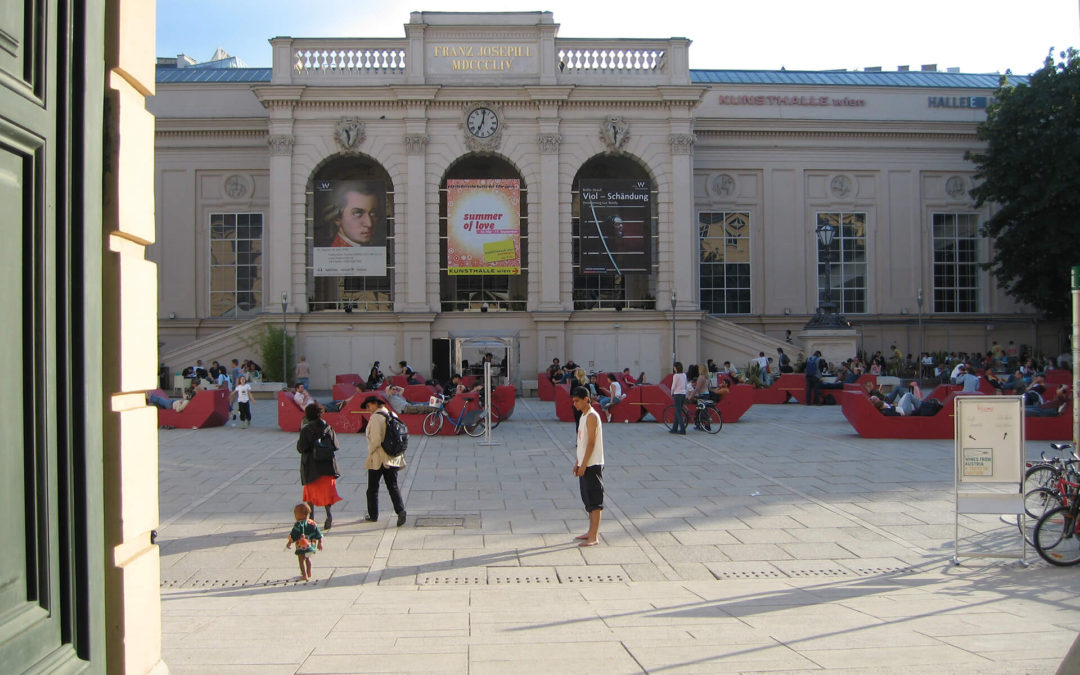Vienna a Grand Love (Urbane Magazine June 2006)
By Margaret Swaine
Vienna’s a sophisticated seductress. It has the architectural beauty of Paris without the attitude, the arts culture of London without the traffic jams, the dining scene of New York without the noise and everywhere the sound of music. I’m a seasoned, somewhat spoiled traveler yet it lures me back year after year.
The first night of my first time in Vienna I admit was ignoble. I went to see Beethoven’s opera Fidelio at the beautiful Vienna State Opera House. Productions almost always sell out far in advance and I hadn’t planned well. The best I could do was the last row. At this hot and dizzy height, I gave into jet lag and slept. Even if the opera was a blur, the Renaissance 1869 building, the elegant Viennese society and the champagne pick-me-up salvaged the evening for me. My first night, the city left a distinctly better impression than I did.
I have learned of course that unless you have a very long stay, it’s best to plan for Vienna. There’s always more to do than time allows. My Torontonian friend Alf who keeps an apartment in Vienna says, “It has more museums on any given topic than you can think of.” Every moment becomes precious in this imperial, bustling yet very walkable, capital of Austria. The city bursts with song, dance, arts, wine and food, integral to the Viennese soul.
Mozart lovers in town for the 250th birthday celebrations of the composer have almost too much choice. They can get their fix at the Mozarthaus, where the composer lived from 1784 till 1787, at the free admission outdoor Music Film Festival on Rathausplatz square, at the Theater an der Wien (the perfect Mozart opera house), at Peter Sellar’s “New Crowned Hope” festival and list goes on. Naturally the Vienna State Opera is also staging some Mozart classics.
For dancers, the call to “Alles Walzer” is mostly heard between New Year’s Eve and mid-March every year when some 270 balls take place. Viennese love celebrating Carnival, the days preceding Lent season, called Fasching in Vienna. The balls take place in generally grand surroundings such as a former town palace of a prince or in the coveted grand halls of the Hofburg Imperial Palace. Champagne is the drink of the night and people are dressed to the hilt. Dance schools such as Elmayer’s or Fränzl’s offer ‘crash courses’ in the waltz for left-footed foreigners and others in need. When I attended the Journalists’ Summer Ball I saw enough foot-shuffling dance school dropouts among the whirl of the fancy footed not to feel too embarrassed about my own rusty dance steps. There’s hardly a professional group in Vienna without its own ball. Technologists created the Techniker Cercle, physicians have the Ätzteball and lawyers the Juristenball. Even the chimney sweeps have their night of dance. (Alf tells me those sweeps show up for work in all black with white top hats.) The crowning glory however of the ball season is the Vienna Opera Ball held in the State Opera which is transformed for the night into a giant dance arena.
One of my favourite art haunts in the city is the KunstHausWien. This former 1892 furniture factory features the works of famous Viennese painter and architect Hundertwasser. God broke the mould after Hundertwasser. His KunstHausWien is a self-proclaimed “bastion against the dictatorship of the straight line, the ruler and the T-square”. Above a museum and café are two floors that hold a cross section of Hundertwasser’s imaginative, funky, crazy-shaped, colourful paintings, tapestries and architectural models. The third and fourth floors hold international exhibits – a solo show of over 100 works of Swiss surrealist HR Giger, recognized as one of the world’s foremost artists of Fantastic Realism is being held from now until October. Fans of the Alien films will recognize his oeuvres.
The spectacular MuseumsQuartier, one of the ten largest cultural complexes in the world, unites baroque buildings with new architecture and various disciplines of art in a single location. In the heart of the city, it also has terrace cafés, bars and shops. I always try to spend a good part of a day here. One of the current exhibitions within the complex is “Summer of Love” at the Kunsthalle (to September 3) which relives the sixties and seventies in the works of artists including Verner Panton, Andy Warhol and Richard Hamilton.
Expressionism enthusiasts should not miss the “Round Table: Egon Schiele and his Circle” showing at the Austrian Gallery Belvedere until September 24th. On display are 120 works by Schiele, Gustav Klimt, Oskar Kokoschka and other pioneers of modernism. Masterworks of Venetian painting by great Renaissance artists are on show at the Kunsthistorisches Museum (Museum of Fine Arts). It’s a hoot to have Sunday brunch within the beautiful walls or the unique Thursday buffet where one can munch, view paintings in the museum and return to a reserved table as often as desired.
That brings me to the Austrian’s enthusiasm for good food. Austrians love to eat. Breakfast may be simple enough, often cold cuts, cheese, bread and fruit. But before lunch many fit in either a visit a Konditorei (pastry shop) or a Kaffeehaus (café) for pastry and coffee. There must be at least one of these on every street, often several in a row – likely over 300 in the city. When hunger hits again, before dinner, they fill up once more. Viennese cafés prepare coffee as much as 41 different ways and along with sweets have international newspapers and sometimes even full course meals of traditional food. Lingering over political discussions may be a dying art but hanging out is just fine. A friend apologised once in a Viennese café for only having two coffees in the several hours she reposed there. The waiter said, “But you only had to drink one.” Among the more famous ones, Café Mozart appears in the Orson Welles movie “The Third Man”. The same owners have Café Landtmann, the elegant Viennese institution opened in 1873. Sigmund Freud was a regular and today it still draws famous visitors.
When it comes to dining, Austrian cuisine is speckled with influences from its former imperial possessions. The stuffed pancakes and goulash smack of Hungary, the risotto of northern Italy and even the schnitzel is an import from Italy. The Plachutta restaurants which serve the Viennese classic “tafelspitz”, boiled meats served in a broth with a range of vegetables and garnishes, pack people in. Some of the best meals I had recently were at the airy Restaurant Coburg in the neo-classical Palais Coburg, the Rote Bar at the Sacher Hotel, the “four toque awarded” Steirereck and the Mörwald in the Ambassador Hotel. Top city chefs of those places are magicians at turning traditional ingredients such as beef cheeks, veal lung, calf’s head and the Austrian fish zander, into sophisticated delicacies. A trendy contemporary spot is Wein & Co. I love that I can buy a wine in the adjacent store and bring it into the bar’s dining area to be popped open for a small charge. Alf has it right when he says, “Any street you walk through that you don’t have to, you can get outstanding food at a reasonable price.”
Ah wine. Vienna is the only capital in the world that can boast vineyards within the city limits. It has four wine districts clustered around its jagged border. Inns called heurige are based in any of the dozen or so wine-producing villages within the city limits and are expected to provide wine and food solely of their own production. A Viennese friend told me that there are only 150 to 160 good ones down from 200 a few years ago. The wine is generally an early drinking style of grüner veltliner served in a viertel, a quarter-litre mug. The original idea was institutionalized in 1784 by Emperor Joseph II, whose bones must be smiling at the on-going popularity of these inns.
The best heurige to visit are run by Viennese wine producers. Mayer am Pfarrplatz in Helligenstadt is a perennial favourite which produces a wide range of its own wines. Sitting in the shady garden of a heurige in the summer can be delightful. Austrian wine itself is top notch. My favourite whites in the world are from Austria’s unique grüner veltliner grape which can be made in a variety of styles from light and fruity to serious and complex. Find the higher quality styles at top restaurants.
Walking is a good idea after most indulgence. Walkable Vienna offers more than pretty streets with stunning classical architecture and grassy parks. It has unique tours. On a previous visit I did the sewer walk, tracing the steps that Harry Lime took when he tried to escape capture in The Third Man. The sewers are enormous and not smelly…really. The walk of this year is “Sigmund Freud in Vienna. A City Walk” which takes in eight sites significant to Freud’s life in the city. This includes the aforementioned Café Landtmann. It’s the 150th anniversary of the birth of the founder of psychoanalysis and the Freud Museum has mounted an exhibition called “The Couch: Thinking in Repose”.
I plan to end my busy days in Vienna this year with a hot chocolate treatment at the new Sacher Spa. The Sacher Hotel which opened in 1876 has become a Viennese institution, renowned as a meeting place for nobility, politicians and artists through the years. Graham Greene wrote parts of The Third Man here. Historic hotels can get long in the tooth, but the Sacher is newly resplendent after comprehensive renovation, two new loft floors and the 300 square metre spa. For over a decade Viennese friends have sent me a delicious chocolate Sacher-Torte every Christmas. (The hotel’s 1832 recipe is a closely guarded secret but they ship the decadent cake worldwide.) Opening the etched wooden box brings back beautiful memories. This time I’ll enjoy the chocolate at the spa as my body is slathered with nourishing cocoa butter. From my room I’ll be able to gaze upon the Opera House across the street and think about how my love affair began. The lure continues. What a siren, what a city.
Vienna If You Go
For general tourist information: Austrian National Tourist Office, 2 Bloor Street West, Suite 400 Toronto, ON M4W 3E2 416-967-4867 www.austria.info and www.vienna.info
Austrian Airlines offers daily direct flights to Vienna from Toronto in the summer (Air Canada co-share) for Austrian call 1-800-843-0002 or call Air Canada
The Sacher Hotel internet and shop: www.sacher.com (Tel.: +43 (0)1 – 51 456 0)
KunstHausWien: www.kunsthauswien.com
Vienna State Opera House: www.wiener-staatsoper.at
Theater an der Wien: www.theater-wien.at
Kunsthistorisches Museum: https://www.khm.at/en/

